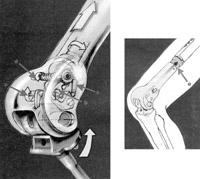Ander Letamendia "The technique of hand transplantation is not difficult, it is long"
2000/02/08 Roa Zubia, Guillermo - Elhuyar Zientzia
• Medical Director and Vascular Surgeon of Pakea •
"The technique of hand transplantation is not difficult, it is long"
This news looks like science fiction news. Much progress has been made on this issue, right?

I would say that despite the success of this news, more than technically, among doctors has surprised by the new approach. The technique is not difficult. It is much more difficult to put your hand in place to someone who hangs for an accident. From France we have already received news of this type. Two years ago the hand of a deceased was applied to a man. We have had no news of the future situation of this hand. It is important to know how this hand has evolved.
When did this type of implant begin?
Implants many years ago. We at the Pamplona University Clinic in the 1960s used these techniques. In 1971 in Tolosa and once in Donostia and Pamplona it was once again sewn part of oneself. What progress has been made? Well, in the field of technique the instruments are getting better, like microscopes. Engineers work hard for doctors. On the other hand, the drugs used for the approval of these implants are becoming lighter and with fewer involuntary effects.
What exactly is the subject that concerns us? Implant, transplant, vaccine...?
The implant or transplant is the same. We call reimplant the relocation of the body part. It is a long process in which to operate, place the bones in place and sew each vein. It lasts between eight and twelve hours. When parts of another are added, these are transplants, if the autologists come from humans and the heterologists come from other species, such as the liver of a monkey.
Organs such as keychain, liver, etc. transplant for a long time, while finger transplants, hands, etc. are more recent. What is the difference between both types of transplants?
Manual technique is more complicated, because many things must be joined. For example, in the blue has been added ureter, arteries and veins and finished the transplant. In the case of the hand, once sewn, the nerves should grow. The speed of growth is very slow, one millimeter per week. To get from the wrists to the fingers must be at least six months. To move the hand correctly it is necessary to perform more operations. Therefore, it is a more complex and longer technique. Technically it is not difficult, but we have to unite many things. However, a deceased's hand is cut to the desired location and wrist that will receive the vaccine. The cut is quite clean. However, this does not happen in an accident. Many times veins are missing and repair is more complicated.
In the last case mentioned in the introduction the hands belonged to a deceased. In these cases the risk of rejection is higher than if it is proper?
Yes, of course. That's the problem of transplants, whether a person accepts it or not. To avoid rejections it is necessary in many cases to give many drugs, very expensive and quite dangerous and with consequences. They will be used progressively for acceptance by the transplant. No problem when it is own. Iron, utensil, etc. may be contaminated or not accepted. we have put on. But what comes from the bodies of others can provoke rejection and although the cut is perfect, it can annul everything.
Can fashion cloning serve for such operations? From the cells themselves, could it be done and put the necessary body branch?
I think it's possible and we don't know how far we're going to go. But it is quite difficult. This news has made us think. He lacked both hands. A dead man has been sought and the most egalitarian. Things may be done in a more prudent way, that is, with a one-handed and artificial transplant and see what happens. There is time to place the other.
They are long operations. The latter was 17 hours. The presence of 20 international surgeons is striking. Why are so many specialists needed?
More people would be needed. A team will be needed for each hand of the deceased. Then, screwing specialists are needed to attach the bones. This should be done very carefully, as the movement of the bone can damage the entire operation. Then you have to tie the veins and nerves one by one and then sew the muscles, tendons and skin. There are many things, so the operation is very long and can not be left until the end. Therefore, the surgeon must rest and, in the meantime, another will continue his work. Many people are required to perform such an operation, including nurses and assistants from each group.
What type of rehabilitation is needed later?
The patient can do nothing. Your brain is unable to move that hand. You will have to perform a passive rehabilitation, that is, another one will help you move and that if you do not dry your muscles. It starts moving slowly, but its capacity is very small. You may be able to eat but not get great skills. However, the technique is advancing a lot and there are many people working on it. What now seems impossible can be tomorrow.

Gai honi buruzko eduki gehiago
Elhuyarrek garatutako teknologia





